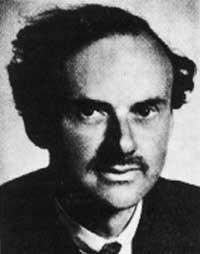PAUL DIRAC
British physicist born in Bristol (Gloucestershire) on August 8, 1902.
He studied electrical engineering at the University of Bristol, but after changing his mind and graduating he maintained mathematics. In 1926 he graduated from the University of Cambridge, becoming a mathematical physicist. In 1932 he joined Cambridge as a professor of mathematics. Dirac is known for his work in theoretical physics. He introduced relativity in wavy mechanics and gave a new interpretation of quantum mechanics.

At the end of the twenties he developed research initiated by De Broiglie. In these studies, both particles and electrons explained that they had wave characteristics. Austrian physicist Schrodinger also investigated the same subject. Dirac proposed some equations that indicated that the electron could have two energy states, one positive and one negative. This idea was applicable to the electric charge, since the electron was negatively charged and, therefore, there should be another similar particle positively charged. In view of this, the first thing that was thought was that the other particle was proton. But this idea was not correct. Although the proton had a positive charge, it had nothing to do with the electron, since its mass was 1.836 times higher than that of the electron.
Therefore, in 1930 Dirac suggested that there should be a particle with the same mass of the electron but positively charged. The previous equation also served for the case of the proton. He postulated that there should be a particle with negative charge but the same mass of the proton. Oppenheimer, a U.S. physicist, helped check this idea.
These particles were called antiparticles. Although at first Dirac's theory was rare, immediately after publication the American physicist Anderson confirmed it. Two years later he discovered the antielectron or positron.
After the fourth of a century, the American physicist Segrè discovered the antiproton. In the following years unknown particles and their respective antiparticles were detected. Ideas have also been extended on the existence of forms of matter composed exclusively of antiparticles.
Dirac received with Schrodinger the Nobel Prize in Physics in 1933. He died in Tallahassee (Florida) in 1984.
Buletina
Bidali zure helbide elektronikoa eta jaso asteroko buletina zure sarrera-ontzian











